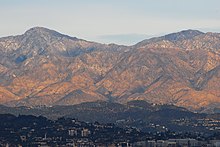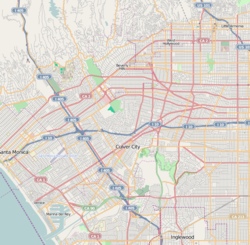Baldwin Hills/Crenshaw, Los Angeles
Baldwin Hills/Crenshaw | |
|---|---|
 Map of the Baldwin Hills/Crenshaw neighborhood of Los Angeles, as delineated by the Los Angeles Times | |
| Coordinates: 34°1′12.15″N 118°21′23.81″W / 34.0200417°N 118.3566139°W | |
| Country | |
| State | |
| City | Los Angeles |
| Area code | 323 |
Baldwin Hills/Crenshaw is a neighborhood in the south region of the city of Los Angeles.[1][2][3] It is divided between the upscale, principally home-owning Baldwin Hills residential district to the south and a more concentrated apartment area to the north, just south of Jefferson Boulevard. A commercial corridor along Crenshaw Boulevard includes Baldwin Hills Crenshaw Plaza, Marlton Square and Crenshaw Boulevard.
History
19th century
Timeline

- "Lucky" Baldwin: Baldwin Hills and other surrounding geography are named for the noted 19th-century horse racing and land development pioneer, Elias J. "Lucky" Baldwin.
- Rancho La Cienega o Paso de la Tijera: historic early-19th-century eastern hills Rancho land grant.[4][5]
- Rancho Rincon de los Bueyes: original early-19th-century western section Rancho land grant.
- Olympic Village: The Baldwin Hills were the site of the very first Olympic Village ever built, for the 1932 Los Angeles Summer Olympic Games. Built for male athletes only, the village consisted of several hundred buildings, including post offices and telegraph offices, an amphitheater, a hospital, a fire department, and a bank. Female athletes were housed at the Chapman Park Hotel on Wilshire Boulevard. The Olympic Village were demolished after the Summer Olympic Games.[6]
Geography
Description
According to the Mapping L.A. project of the Los Angeles Times, Baldwin Hills/Crenshaw is bounded by Culver City, Jefferson Park, Ladera Heights, View Park-Windsor Hills and West Adams. Areas within it are Baldwin Village, Baldwin Vista, The Dons and Village Green.[3][7] The neighborhood limits, according to Mapping L.A, are Jefferson Boulevard on the north, Ballona Creek, Jefferson Boulevard and La Brea Avenue on the west, the Kenneth Hahn State Recreation Area and Stocker Street on the south and Crenshaw Boulevard on the east.[3]
Neighborhoods
Baldwin Hills/Crenshaw contains several neighborhoods:[7]
- Baldwin Hills
- Baldwin Hills Estates ("The Dons")
- Baldwin Vista
- An unincorporated portion outside Los Angeles city limits
- Baldwin Village
- Crenshaw
- Crenshaw Manor - Crenshaw Manor is bordered by Crenshaw Blvd to the east, W. Martin Luther King Jr. Blvd to the south, W. Exposition Blvd to the north, and Farmdale Avenue/Chesapeake Ave/Coliseum St. to the West.[8]
Population
The 2000 U.S census counted 30,123 residents in Baldwin Hills/Crenshaw and its area of 2.88 square miles gave it a population density of 10,446 people per square mile, about average for Los Angeles and the county as a whole. In 2008 the city estimated that 32,234 people lived there. The median age was 36, older than the city as a whole. The percentage of residents aged 65 and older was among the county's highest.[3]
Ethnic composition
The neighborhood was considered "moderately diverse"[9] in 2000, with 71.3% of residents being of black or African-American ancestry, 17.3% Latino, 4.7% Asian, 3.3% white and 3.4% of other backgrounds. The neighborhood had the fifth-highest concentration of black residents in the city.[3][10]
The average household size was 2.3 people, low compared to the city as a whole. Almost 32% of the 2,400 families living in Baldwin Hills-Crenshaw were headed by single parents,[3] the third-highest rate in the city, after Watts and Vermont Knolls.[11]
The median household income at $37,948 in 2008 dollars was low compared with both city and county populations. The percentage of households earning $20,000 or less a year was high for the county. The percentage of residents 25 and older with a high school education and some college was high for the county, Those with a college degree were about the same as the rest of the city and county.[3]
The large number of veterans, 2,272 or 10.2% of the population, was high for both the city and the county. The percentage of veterans who served during World War II or the Korean War was among the county's highest.[3]
Only 16.6% of the residents were foreign born, a low figure for both the city and the county. Mexico (31%) and El Salvador (16.8%) were the most common foreign places of birth.[3]
Disasters

On December 14, 1963, a crack appeared in the Baldwin Hills Dam impounding the Baldwin Hills Reservoir. Within a few hours, water rushing through the crack eroded the earthen dam, gradually widening the crack until the dam failed catastrophically at 3:38 pm. Although the area had been evacuated after the crack had been discovered, several homes were destroyed, and most of Baldwin Vista and the historic Village Green community were flooded. The dam's failure was ultimately determined to be the result of subsidence, caused by overexploitation of the Inglewood Oil field. The dam's failure prompted the Los Angeles Department of Water and Power to close and drain other small local reservoirs with similar designs, such as the Silver Lake Reservoir. The Baldwin Hills Dam was not rebuilt—instead, the empty reservoir was demolished, filled with earth, landscaped, and converted to Kenneth Hahn Regional Park.[citation needed]
During the summer of 1985, an arsonist started a brush fire along La Brea Avenue. The fire spread up the canyon towards the expensive homes along Don Carlos Drive in the Baldwin Hills Estates tract. Many homes were destroyed despite the efforts of the Los Angeles Fire Department to suppress the flames. The fire killed three people and destroyed 69 homes;[12] the arsonist was never caught.
Parks and recreation

- Baldwin Hills Scenic Overlook:[13][14] The 8.5-acre (3.4 ha) park is open daily from 8 a.m. to sunset. The Visitor Center is open Thursday–Sunday from 10 a.m. to 5 p.m. The park includes an amphitheater, drinking water, the Evan Frankel Discovery Center, gardening boxes, picnic tables, a permeable parking lot ($6), toilets, and walking paths with a central feature known as the Culver City Stairs. The Visitor Center has a guide to the native plants of the area and history of Culver City.[15]
- Kenneth Hahn State Regional Park: recreation and sports areas, and preservation of the open-space lands and native habitats: entrance on South La Cienega Boulevard.[16]
- Norman O. Houston Park[17]
- Jim Gilliam Recreation Center[18]
Government
The Los Angeles Fire Department Station 94 serves the neighborhood.
Library
The Los Angeles Public Library operates the Baldwin Hills Branch Library.[19]
Notable people
- Richard Elfman and Danny Elfman, musicians[20]
- Nipsey Hussle, rapper, entrepreneur and community activist
- Ice Cube, rapper and actor[21]
- Meghan Markle, Duchess of Sussex, actress and wife of Prince Harry, Duke of Sussex
- Darryl Strawberry, professional baseball player[22]
- De'Anthony Thomas, professional football player[23]
See also
- Baldwin Hills (mountain range)
- Baldwin Hills, Los Angeles
- South Los Angeles
- List of districts and neighborhoods in Los Angeles
References
- ^ Díaz, Alexa (May 4, 2019). "Street officially renamed Obama Boulevard in Baldwin Hills/Crenshaw ceremony". Los Angeles Times. Retrieved 2019-05-06.
- ^ Díaz, Alexa (4 May 2019). "Obama Boulevard is a symbol of hope — and resistance — for Baldwin Hills/Crenshaw area". Los Angeles Times. Retrieved 2019-05-04.
- ^ a b c d e f g h i [1] "Baldwin Hills/Crenshaw," Mapping LA, Los Angeles Times
- ^ a b "Rancho La Cienega O'Paso de La Tijera". Laokay.com. Retrieved August 22, 2010.
- ^ U.S. Geological Survey Geographic Names Information System: Rancho La Cienega o Paso de la Tijera
- ^ "1932 Los Angeles Olympic Athlete's Village in the Baldwin Hills". Baldwinhillspark.info. Retrieved November 12, 2007.
- ^ a b [2] "South L.A.," Mapping L.A., Los Angeles Times
- ^ "Crenshaw Manor, Los Angeles, CA neighborhood | Nextdoor".
- ^ [3] Diversity "measures the probability that any two residents, chosen at random, would be of different ethnicities. If all residents are of the same ethnic group it's zero. If half are from one group and half from another it's .50." —Los Angeles Times
- ^ [4] "Black," Mapping L.A., Los Angeles Times
- ^ "Single Parents," Mapping L.A., Los Angeles Times
- ^ Pollard-Terry, Gayle (October 29, 2006). "Years later, the pitch still delivers". Neighborly Advice. Los Angeles Times. p. K2.
- ^ Baldwin Hills Scenic Overlook. accessed 8/22/2010
- ^ "trail map" (PDF). Retrieved 2012-09-13.
- ^ "Baldwin Hills Recreation Center Archived 2010-02-28 at the Wayback Machine". City of Los Angeles. Retrieved on March 23, 2010.
- ^ "Kenneth Hahn State Park". Parks.ca.gov. Retrieved August 22, 2010.
- ^ "Norman O. Houston Park website". Laparks.org. Retrieved 2012-09-13.
- ^ "Jim Gilliam Recreation Center website". Laparks.org. Retrieved 2012-09-13.
- ^ "Baldwin Hills Branch Library". Los Angeles Public Library. Retrieved on March 23, 2010.
- ^ "Elfman in L.A." Elfman.filmmusic.com. Archived from the original on 2011-10-01. Retrieved 2011-01-02.
- ^ Marrow, Tracy; Century, Douglas (2011). "Cold as Ice". Ice: A Memoir of Gangster Life and Redemption—from South Central to Hollywood. Random House. pp. 5–13. ISBN 978-0-345-52328-0.
- ^ "Darryl Strawberry Statistics and History". Baseball-Reference.com. Retrieved 2012-05-23.
- ^ Glicksman, Ben (December 21, 2010). "Crenshaw football star De'Anthony Thomas has Hollywood flair". Sports Illustrated.

